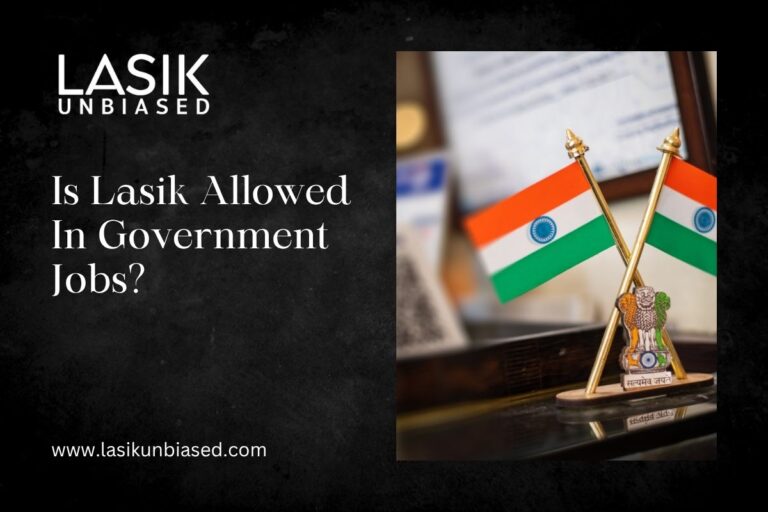Yes, LASIK is allowed for many government jobs in India, but eligibility depends on the specific department, post, and strict medical criteria.
Some roles permit candidates with LASIK, while others do not.
This guide breaks down LASIK eligibility across major government sectors, including the armed forces, police, civil services, and railways, so you can make an informed decision about your career and vision correction.
Understanding LASIK and Government Job Requirements
LASIK (Laser-Assisted In Situ Keratomileusis) is a popular eye surgery to correct refractive errors like myopia, hyperopia, and astigmatism. While it offers freedom from glasses or contact lenses, many government job aspirants wonder: Will LASIK affect my eligibility for government service?
The answer is nuanced. Each government department sets its own medical standards, especially for posts where perfect vision is critical. Below, you’ll find a sector-wise breakdown.
LASIK Eligibility in the Indian Armed Forces
Indian Army: Who Can and Cannot Apply After LASIK?
Not Allowed:
- 10+2 entries (NDA, TES, and equivalent): LASIK or similar procedures are strictly not permitted for these categories.
Allowed (With Conditions):
- Graduate & Equivalent Entries (CDSE, IMA, OTA, UES, NCC, TGC, etc.)
- Postgraduate & Equivalent Entries (JAG, AEC, APS, RVC, TA, AMC, ADC, SL, etc.)
Key LASIK Criteria for the Army:
- Surgery after age 20
- At least 12 months post-surgery
- Central corneal thickness ≥ 450 microns
- Axial length ≤ 26 mm
- Residual refraction ≤ ±1.0 D (including cylinder)
- Healthy retina and normal corneal topography
- Radial keratotomy (RK) is a permanent disqualification
Documentation: You must provide a certificate/operative notes from the medical center detailing the surgery. Absence of documentation can lead to rejection as “Unfit due to undocumented Visual Acuity corrective procedure.”
Indian Navy: LASIK Rules by Branch
Allowed (Except Special Cadres):
- LASIK, PRK, and SMILE are permitted for all branches except submarine, diving, and MARCO cadres.
Key Criteria:
- Surgery after age 20
- At least 12 months post-surgery
- Axial length ≤ 26 mm; corneal thickness ≥ 450 microns
- Residual refraction ≤ +1.0 D Sph or Cyl (nil for Pilot/Observer entries)
- Pre-op refractive error ≤ ±6.0 D
- Normal retina
- RK is a permanent disqualification for all branches
Indian Air Force: When Is LASIK Accepted?
Allowed (With Conditions):
- Surgery after age 20
- At least 12 months post-stable, uncomplicated surgery
- Axial length ≤ 26 mm
- Corneal thickness ≥ 450 microns
- Residual refraction ≤ ±1.0 D Sph or Cyl (where correctable refractive errors are permitted)
- RK and pre-op refractive error > 6 D are not allowed
LASIK in Central Armed Police Forces (CAPF), BSF, CRPF, ITBP, AR
CAPF (Including BSF, CRPF, ITBP, AR)
General Rule: LASIK is permitted for most officer-level posts, but not for all ranks.
CAPF Officer Eligibility:
- Age: 18–35 years
- Axial length: 21–26 mm
- Corneal thickness: ≥ 425 microns
- Pre-LASIK error: ≤ 6 D
- At least 6 months post-surgery
- Stable vision and normal retina
BSF & Assam Rifles (Non-Officer):
- “Visual correction of any kind is not permitted even by glasses.” LASIK is not allowed for these posts.
CRPF: Minimum vision must be 6/6 in one eye and 6/9 in the other, without correction (no glasses or LASIK).
ITBP: LASIK is allowed for gazetted officers only, with similar criteria as CAPF.
LASIK in Police Services
Delhi Police
Permitted: LASIK is allowed for Constable (Exe.), Women Constable (Exe.), Sub-Inspector (Exe.), and Women Sub-Inspector (Exe.) posts.
Vision Standard: 6/12 with or without glasses in both eyes.
LASIK in Civil Services (IAS, IPS, IFS)
Permitted: Spectacles, contact lenses, and refractive surgeries (LASIK, ICL, IOL) are allowed for both technical and non-technical services.
- Technical Services: High colour vision and binocular vision required.
- Non-Technical Services: Lower colour vision standards, binocular vision not mandatory.
- Vision Standard: 6/6 distant vision, J1 near vision (with or without correction).
Note: Candidates are referred to a Special Ophthalmic Board for final assessment.
LASIK for Narcotics Control Bureau, NIA, CBI
Permitted: Eye-sight standards are 6/6 in one eye and 6/9 in the other (with or without glasses). Near vision 0.6 in one eye and 0.8 in the other. (Note: LASIK is not specifically mentioned in the official guidelines.)
LASIK in Indian Railways
Not Allowed: For posts with Medical Standards A-2 & A-3 (includes ALP—Assistant Loco Pilot).
Allowed (With Conditions): For Medical Standards B-1, B-2, C-1, and C-2, if:
- No LASIK complications
- At least one year post-surgery, with a medical certificate
- Residual corneal thickness ≥ 425 microns
- Normal fundus, no progressive eye disease
LASIK in DRDO
Not Allowed: For Security Assistant ‘A’, Fire Engine Driver ‘A’, and Fireman, where natural unaided vision of 6/6 is required.
Other Posts: No explicit mention of LASIK; requirements may vary.
Quick Reference Table: LASIK Eligibility in Major Government Jobs
| Sector/Post | LASIK Allowed? | Key Conditions |
| Army (10+2 entries: NDA, TES) | No | Not permitted |
| Army (Graduate/Postgraduate entries) | Yes | Strict criteria (age, thickness, etc.) |
| Navy (Except special cadres) | Yes | Not for submarine/diving/MARCO |
| Navy (Submarine, Diving, MARCO) | No | Not permitted |
| Air Force | Yes | Strict criteria (age, thickness, etc.) |
| CAPF Officers (Gazetted) | Yes | Age, thickness, axial length, 6 months post-op |
| BSF/Assam Rifles (Non-Officer) | No | No correction allowed |
| CRPF (Non-Officer) | No | No correction allowed |
| ITBP (Gazetted) | Yes | Similar to CAPF |
| Delhi Police | Yes | 6/12 vision with/without glasses |
| IAS/IPS/IFS | Yes | Allowed for all, referred to board |
| Railways (A-2, A-3, ALP) | No | Not permitted |
| Railways (B-1, B-2, C-1, C-2) | Yes | 1 year post-op, thickness, certificate |
| DRDO (Certain posts) | No | 6/6 unaided required |
| DRDO (Other posts) | Varies | Check specific notification |
What to Remember Before Opting for LASIK?
- Always check the latest official notification for your target job. Rules can change.
- Maintain all medical documentation related to your LASIK procedure.
- Meet the minimum post-surgery waiting period (usually 6–12 months).
- Ensure your pre- and post-surgery eye measurements (corneal thickness, axial length, residual refraction) fit the required standards.
- Avoid LASIK before age 20 if you plan to apply for defence or police jobs.
Key Takeaways and Action Steps
LASIK can open doors to many government jobs, but it can also close some if you don’t meet strict medical standards. If you’re considering LASIK and a government career, research your desired post’s requirements before surgery. For many officer-level and administrative roles, LASIK is accepted if you meet the prescribed criteria. However, for technical, combat, and driving roles, natural or uncorrected vision is often mandatory.
Plan your career and vision correction wisely.
If you have more questions about a specific post or want to know about other medical standards, check the latest recruitment notifications or consult a medical professional familiar with government job requirements.


